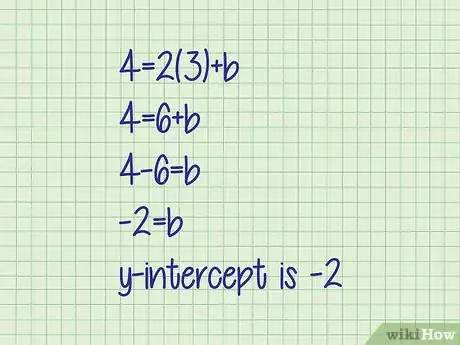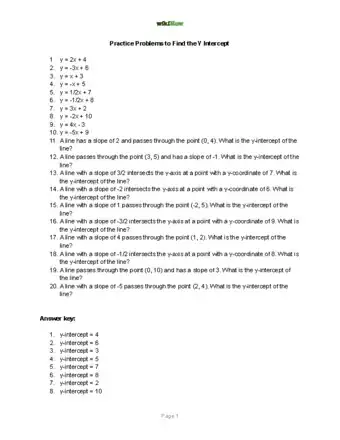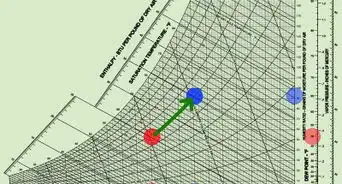This article was co-authored by Grace Imson, MA. Grace Imson is a math teacher with over 40 years of teaching experience. Grace is currently a math instructor at the City College of San Francisco and was previously in the Math Department at Saint Louis University. She has taught math at the elementary, middle, high school, and college levels. She has an MA in Education, specializing in Administration and Supervision from Saint Louis University.
There are 8 references cited in this article, which can be found at the bottom of the page.
This article has been viewed 1,229,499 times.
On their own, y-intercepts aren’t complicated at all—they’re simply points where the graph of the equation intersects with the Y-axis.[1] But how are you supposed to find a y-intercept when you only have a limited amount of info on hand? Thankfully, it’s not nearly as hard as it looks. We’ll walk you through all the major ways to find the y-intercept when you already have the slope and a point, two points, or just want to use a simple equation. With a little practice, you can make quick work of any y-intercept problem that comes your way.
Steps
Finding the Y-Intercept from the Slope and Point
-
1Write down the slope and point.[2] The slope or "rise over run" is a single number that tells you how steep the line is. This type of problem also gives you the (x,y) coordinate of one point along the graph. Skip to the other methods below if you don't have both these pieces of information.
- Example 1: A straight line with slope 2 contains the point (-3,4). Find the y-intercept of this line using the steps below.
-
2Learn the slope-intercept form of an equation. Any straight line can be written as an equation in the form y = mx + b. When the equation is in this form, the variable m is the slope, and b is the y-intercept.Advertisement
-
3Substitute the slope in this equation. Write the slope-intercept equation, but instead of m, use the slope of your line.
-
Example 1 (cont.): y = mx + b
m = slope = 2
y = 2x + b
-
Example 1 (cont.): y = mx + b
-
4Replace x and y with the coordinates of the point. Any time you have the coordinates of a single point on your line, you can substitute those x and y coordinates for the x and y in your line equation. Do this for the equation you've been working on.
-
Example 1 (cont.): The point (3,4) is on this line. At this point, x = 3 and y = 4.
Substitute these values into y = 2x +b:
4 = 2(3) + b
-
Example 1 (cont.): The point (3,4) is on this line. At this point, x = 3 and y = 4.
-
5Solve for b. Remember, b is the y-intercept of the line. Now that b is the only variable in the equation, rearrange to solve for this variable and find the answer.
-
Example 1 (cont.): 4 = 2(3) + b
4 = 6 + b
4 - 6 = b
-2 = b
The y-intercept of this line is -2.
-
Example 1 (cont.): 4 = 2(3) + b
-
6Write this as a coordinate point. The y-intercept is the point where the line intersects with the y-axis. Since the y-axis is located at x = 0, the x coordinate of the y-intercept is always 0.
- Example 1 (cont.): The y-intercept is at y = -2, so the coordinate point is (0, -2).
Using Two Points
-
1Write down the coordinates of both points.[3] This method covers problems that only tell you two points on a straight line.[4] Write each point coordinate down in (x,y) form.
- Example 2: A straight line passes through points (-1, 2) and (3, -4). Find the y-intercept of this line using the steps below.
-
2Calculate the rise and run. Slope is a measure of how much vertical distance the line moves for each unit of horizontal distance. You may have heard this described as "rise over run" ().[5] Here's how to find these two quantities from two points:
- "Rise" is the change in vertical distance, or the difference between the y-values of the two points.
- "Run" is the change in horizontal distance, or the difference between x-values of the same two points.
-
Example 2 (cont.): The y-values of the two points are 2 and -4, so the rise is (-4) - (2) = -6.
The x-values of the two points (in the same order) are 1 and 3, so the run is 3 - 1 = 2.
-
3Divide rise by run to find the slope. Now that you know these two values, plug them into "" to find the slope of the line.
- Example 2 (cont.): -3.
-
4Review the slope-intercept form. You can describe a straight line with the formula y = mx + b, where m is the slope and b is the y-intercept.[6] Now that we know the slope m and a point (x,y), we can use this equation to solve for b, the y-intercept.
-
5Fit the slope and point into the equation. Take the equation in slope-intercept form and replace m with the slope you calculated. Replace the x and y terms with the coordinates of a single point on the line.[7] It doesn't matter which point you use.
-
Example 2 (cont.): y = mx + b
Slope = m = -3, so y = -3x + b
The line includes a point with (x,y) coordinates (1,2), so 2 = -3(1) + b.
-
Example 2 (cont.): y = mx + b
-
6Solve for b. Now the only variable left in the equation is b, the y-intercept. Rearrange the equation so b is on one side, and you have your answer.[8] Remember, the y-intercept always has an x-coordinate of 0.
-
Example 2 (cont.): 2 = -3(1) + b
2 = -3 + b
5 = b
The y-intercept is at (0,5).
-
Example 2 (cont.): 2 = -3(1) + b
Using an Equation
-
1Write down the equation of the line. If you already have the equation of the line, you can find the y-intercept with a little algebra.[9]
- Example 3: What is the y-intercept of the line x + 4y = 16?
- Note: Example 3 is a straight line. See the end of this section for an example of a quadratic equation (with a variable raised to the power of 2).
-
2Substitute 0 for x. The y-axis is a vertical line along x = 0. This means any point on the y-axis has an x-coordinate of 0, including the y-intercept of the line. Plug in 0 for x in the line equation.
-
Example 3 (cont.): x + 4y = 16
x = 0
0 + 4y = 16
4y = 16
-
Example 3 (cont.): x + 4y = 16
-
3Solve for y. The answer is the y-intercept of the line.
-
Example 3 (cont.): 4y = 16
y = 4.
The y-intercept of the line is 4.
-
Example 3 (cont.): 4y = 16
-
4Confirm by graphing (optional). To check your answer, graph the equation as neatly as you can. The point where the line crosses the y-axis is the y-intercept.
-
5Find the y-intercept for a quadratic equation. A quadratic equation includes a variable (x or y) raised to the power of 2. You can solve for y with the same substitution, but since the quadratic describes a curve, it could intercept the y-axis at 0, 1, or 2 points. This means you may end up with 0, 1, or 2 answers.
-
Example 4: To find the y-intercept of , substitute x = 0 and solve the quadratic equation.
In this case, we can solve by taking the square root of both sides. Remember, when taking a square root, you must account for two answers: a negative and a positive.
y = 1 or y = -1. These are both y-intercepts of this curve.
-
Example 4: To find the y-intercept of , substitute x = 0 and solve the quadratic equation.
Practice Problems and Answers
Expert Q&A
-
QuestionHow do you find the x-intercept in y = mx + b?
 David JiaDavid Jia is an Academic Tutor and the Founder of LA Math Tutoring, a private tutoring company based in Los Angeles, California. With over 10 years of teaching experience, David works with students of all ages and grades in various subjects, as well as college admissions counseling and test preparation for the SAT, ACT, ISEE, and more. After attaining a perfect 800 math score and a 690 English score on the SAT, David was awarded the Dickinson Scholarship from the University of Miami, where he graduated with a Bachelor’s degree in Business Administration. Additionally, David has worked as an instructor for online videos for textbook companies such as Larson Texts, Big Ideas Learning, and Big Ideas Math.
David JiaDavid Jia is an Academic Tutor and the Founder of LA Math Tutoring, a private tutoring company based in Los Angeles, California. With over 10 years of teaching experience, David works with students of all ages and grades in various subjects, as well as college admissions counseling and test preparation for the SAT, ACT, ISEE, and more. After attaining a perfect 800 math score and a 690 English score on the SAT, David was awarded the Dickinson Scholarship from the University of Miami, where he graduated with a Bachelor’s degree in Business Administration. Additionally, David has worked as an instructor for online videos for textbook companies such as Larson Texts, Big Ideas Learning, and Big Ideas Math.
Academic Tutor Find the x-intercept by plugging in 0 for the value of y. The x-intercept will equal whatever value comes out at the other end of the equation.
Find the x-intercept by plugging in 0 for the value of y. The x-intercept will equal whatever value comes out at the other end of the equation. -
QuestionWhat do you mean by x-intercept in math?
 David JiaDavid Jia is an Academic Tutor and the Founder of LA Math Tutoring, a private tutoring company based in Los Angeles, California. With over 10 years of teaching experience, David works with students of all ages and grades in various subjects, as well as college admissions counseling and test preparation for the SAT, ACT, ISEE, and more. After attaining a perfect 800 math score and a 690 English score on the SAT, David was awarded the Dickinson Scholarship from the University of Miami, where he graduated with a Bachelor’s degree in Business Administration. Additionally, David has worked as an instructor for online videos for textbook companies such as Larson Texts, Big Ideas Learning, and Big Ideas Math.
David JiaDavid Jia is an Academic Tutor and the Founder of LA Math Tutoring, a private tutoring company based in Los Angeles, California. With over 10 years of teaching experience, David works with students of all ages and grades in various subjects, as well as college admissions counseling and test preparation for the SAT, ACT, ISEE, and more. After attaining a perfect 800 math score and a 690 English score on the SAT, David was awarded the Dickinson Scholarship from the University of Miami, where he graduated with a Bachelor’s degree in Business Administration. Additionally, David has worked as an instructor for online videos for textbook companies such as Larson Texts, Big Ideas Learning, and Big Ideas Math.
Academic Tutor The x-intercept is just wherever the graph crosses the x-axis (the straight, horizontal line that cuts through the middle of the graph).
The x-intercept is just wherever the graph crosses the x-axis (the straight, horizontal line that cuts through the middle of the graph). -
QuestionIf I have (3, -12) as my points and an x-intercept of one, what would the y-intercept be?
 DonaganTop AnswererSolve by using Method 2 above. You need two points to use that method. One point is given as (3,-12). The second point is the given x-intercept, which is (1,0).
DonaganTop AnswererSolve by using Method 2 above. You need two points to use that method. One point is given as (3,-12). The second point is the given x-intercept, which is (1,0).
References
- ↑ http://www.math.com/school/subject2/lessons/S2U4L2GL.html
- ↑ https://www.khanacademy.org/math/algebra-home/alg-linear-eq-func/alg-writing-slope-intercept-equations/v/finding-y-intercept-given-slope-and-point
- ↑ https://www.khanacademy.org/math/algebra/two-var-linear-equations/writing-slope-intercept-equations/v/equation-of-a-line-3
- ↑ https://www.mathplanet.com/education/algebra-1/formulating-linear-equations/writing-linear-equations-using-the-slope-intercept-form
- ↑ Grace Imson, MA. Math Teacher. Expert Interview. 1 November 2019.
- ↑ Grace Imson, MA. Math Teacher. Expert Interview. 1 November 2019.
- ↑ Grace Imson, MA. Math Teacher. Expert Interview. 1 November 2019.
- ↑ Grace Imson, MA. Math Teacher. Expert Interview. 1 November 2019.
- ↑ http://www.webmath.com/equline3.html
About This Article
To find the y intercept using the equation of the line, plug in 0 for the x variable and solve for y. If the equation is written in the slope-intercept form, plug in the slope and the x and y coordinates for a point on the line to solve for y. If you don't know the slope, calculate it by dividing the rise of the line by the run. If you want to find the y-intercept if you only know 2 points along the line, keep reading the article!




















































































